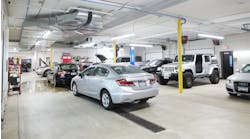Over the past year, even the best shops have been battling with trying to stabilize car count. It hurts technicians, service managers and families of shop owners all across North America. We all know what is causing it. But what can we do about it? I was listening to Rick Johnson, a Nebraska shop owner and ATI coach, explain how to solve the problem. He began by asking, “Do you know how many times a year your customers are coming in to visit your shop?”
In today’s fast-paced world, it is amazing how easily we can lose track of customers. And when we finally realize, “Boy, it’s been a while since Bob was in,” it often is too late. We have lost Bob to another shop, and we wonder, “How did that happen?” What do you think is a good number for visit frequency in your shop today with the longer mileage intervals between oil changes? Of course the good old standby number was four times a year, with oil changes being scheduled for every three months and 3,000 miles.
With today’s ever-increasing intervals between oil changes, I believe that the minimum number is now 2.5 times a year. We need to see our customers that often to ensure we are properly taking care of their needs and maintaining their cars. A few shop management systems out there will allow you to run a report to see just what your visit frequency is, and I would encourage you to do that. However, a large percentage of the shop management systems do not have that function.
Another important number to know is your customers who visit you once and never come back in a year’s time. We spend a lot of time and money on marketing and promotions. To have a customer respond to that effort and then never return is not only costly, it hurts. And to not track this number and not be able to follow up on it is insane. I know what you’re thinking — numbers, numbers and tracking. We have all heard these things. But you know what? The numbers are where it’s at. Every successful business that I know of tracks its important numbers and can refer to them at the drop of a hat.
Your doctor is all about numbers as well, right? Your blood pressure, cholesterol numbers, heart rate, etc., all are important for evaluating your health. The doctor watches those numbers, and when something is not right, he or she checks into it and makes corrections to keep you running and healthy. The same needs to be done with your business. Learn the numbers of your business. And starting with visit frequency and one-time visits is a great way to evaluate your shop’s health.
What can we learn from a shop that has a visit frequency of less than 2.5? What could that mean? Almost every time, it means to me that we have a problem on the counter. We have a service advisor who is just not doing his or her job. This can be from many different causes. We can have an advisor who needs more training; we can have an advisor who is trained but has burnt out. It also can mean that the advisor has no faith in the techs and so cannot and will not sell, to avoid the problems that go with poor workmanship. There can be many reasons, but first we have to start by knowing those visit frequency numbers, don’t we?
Once we find we have fewer than 2.5 visits, we have our work cut out for us. We need to make some calls and ask our customers what is going on. Maybe observe the counter and listen in on some phone calls. And man oh man, can you learn a lot from some mystery phone shopping. But you better be sure your blood pressure and heart can take the stress of what you might hear! I know it’s tough out there today; believe me, I see it and hear it every day. These advisors have to be on top of their game each and every day. But you have to realize that if your customers are not visiting your shop at least 2.5 times a year, they are going somewhere else. Someone else is taking care of your customers and selling them the maintenance and repair that you should be getting. After all, no one can take as good care of your customer as you can, right? I mean, your advisor is exit scheduling (setting up next appointment) as the customer is cashed out, right? I am quite confident that the advisor is doing follow-up calls on all customers to let them know how much he or she appreciates them and loves them, right?
Lonely Visitors
Now on the one-time visits in a year, if one number tells us something is wrong, it is the one-time visit. A customer finally responds to our advertising efforts, they come to the shop and for whatever reason we don’t “wow” them. We show them that we are just like every other shop and they choose not to come back. Man, that hurts. We can have the best website, the best Google presence, the best location, the nicest waiting room, etc. But if that advisor does not wow that customer and make them feel wanted, then the customer may decide to keep looking for “his shop” or “her shop.” What a waste of money and time for us.
Of course some one-time visits are fine; we all have the tourists that break down, and they obviously are not coming back. We unfortunately lose customers to death, and some move away or buy a new car. And some we just flat out cannot make happy and we are glad that they don’t come back! But the others, the ones that used to be great customers — what happened to them? The ones that should have become great customers — what happened to them? First off, we have to find out who fits these categories. Then we need to start making calls to see what happened and see if we can correct it and get them back.
I hear all the time from shop owners that they sure wish it was like it was in 2007 or before. I understand that to mean it was a lot easier to make sales before the recession. But sadly, I have news for you: Those days are not coming back! It will never be like that again. And to this I say “Good!” For those shops that will make changes, it can be better than ever, and you will have so much less competition. I would suggest that we can have the sales like 2007 or even better. But we simply cannot run the business with 2007 sales techniques. We have to know the numbers better than ever now if we expect to have great sales. We also have to do the things we maybe did not do in 2007.
I hear things like “I never had to exit schedule before” or “I never made follow-up calls before.” Well buddy, you better be doing those things now if you want 2007 results! So, what are we to do if our sales management system won’t give us the visit frequency report or the number of one-time visits? Which, by the way, most point-of-sales systems cannot do. Just click on the link www.ationlinetraining.com/2013-5 to be set up with the free ATI Customer Link Frequency Report. It’s free, and priceless in diagnosing your business, and will help you get a handle on your shop’s health at the counter.
Subscribe to Motor Age and receive articles like this every month…absolutely free. Click here



